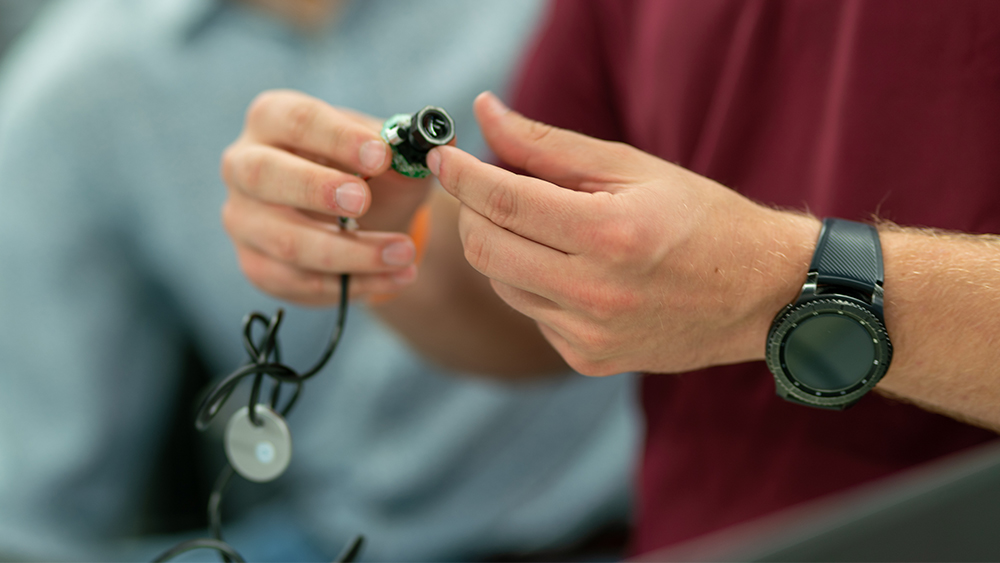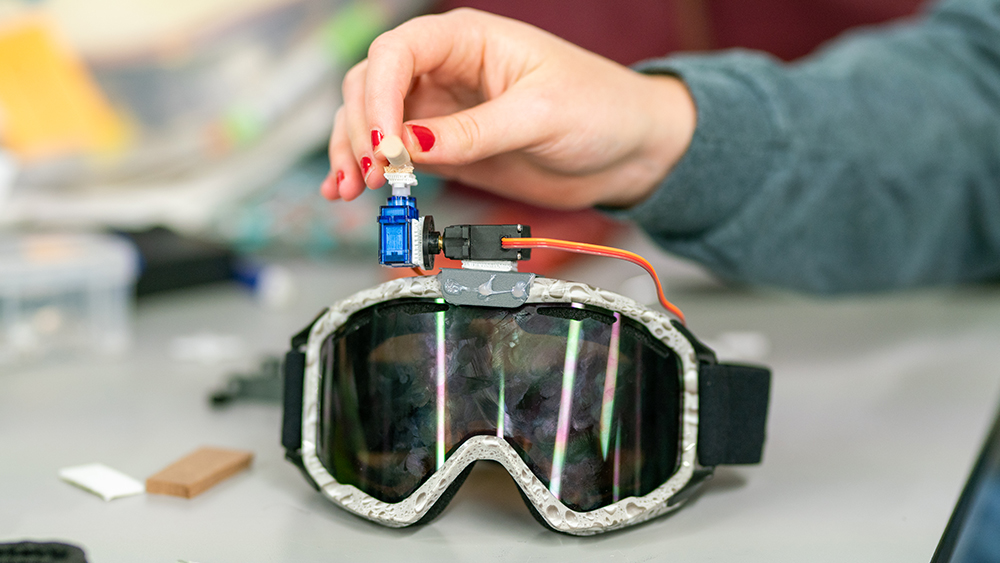On Veterans Day weekend, students from across Texas A&M University joined forces to tackle real problems the military faces today.
During Aggies Invent: Special Operations Command (SOCOM), teams had 48 hours to brainstorm ideas and develop a solution to military operations and communication issues. Teams then marketed their designs to a panel of industry experts.
“Doing an Aggies Invent for military on Veterans Day weekend is really special because we were able to provide solutions to some of their most vexing problems,” said Rodney Boehm, director of the Engineering Entrepreneurship Program at Texas A&M.
One of those problems is debris on aircraft runways. Sticks, wires and bolts litter runways and launch pads, causing millions of dollars in damages.
“The debris can get sucked up into motors, shred tires and destroy helicopter rotors,” explained Patrick Currin, junior mechanical engineering student and member of the first-place team FODBOT.
The current solution for clearing the foreign object debris (FOD), involves hundreds of soldiers spending hours walking the runways to retrieve the waste. As an alternative, their innovation offered an autonomous solution.
Team FODBOT developed a prototype with a three-part process; a dual rotating brush to sweep larger debris into a bin, followed by a magnetic bar to collect smaller pieces of metal and ending with a vacuum to clear anything remaining.
“When you’re doing something in 48 hours, there’s a lot of things that could go wrong, so we decided on a design that was simple but effective,” said Sarojeet Deb, graduate student in mechanical engineering.
For most of the winning team, this was their first time participating in an Aggies Invent and their first hands-on experience in engineering.
“Making the actual working prototype was an amazing experience. I learned skills that I haven’t learned yet as a sophomore,” said Noble Gutierrez, mechanical engineering student.
For Oluwayemisi Awofeso, a junior in public health, the experience was a big step outside of her comfort zone.
I didn’t really know what to expect because I’m not an engineering major, so going into this I was a little bit intimidated, but it went better than I could ever imagine it to have gone. I think I learned a lot.
Other members of team FODBOT included Rebekah Franklin, a sophomore in the Engineering Academy at Blinn-Bryan, and general engineering freshman Vivian Yu.
Placing second was team Dog Operation Gear (D.O.G.) with the design of a technology-driven mask and vest for military working dogs. The concern they addressed was the insufficient communication between today’s forward scout dog and handler.
“We talked to a couple of special operations dog handlers and they told us that their main concern was latency (the lag for receiving real-time commands),” said Massaro Ochoa, freshman general engineering student.
To mitigate the delay in communication, team D.O.G. implemented haptic technology into their vest design that would use vibrations to indicate commands. By utilizing an application, handlers can control this haptic technology as well as monitor the other features equipped on the vest and mask design. These additions included a front and rear camera providing a 360-degree view, pockets for various sensors, protective goggles, a microphone and speaker and an LED light to help the dog see.
For team D.O.G., the opportunity to talk with industry experts about their firsthand experiences was an invaluable resource.

“I’ve never really been exposed to the issues and problems they’re having out in the field, so getting to talk to them and understanding what it’s like on a mission was super cool, and it helped us understand how we, as students, can help them,” said Clara Cliver, senior industrial and systems engineering student.
“I was really impressed with the resources that we were provided, both the mentors who have an incredible wealth of knowledge that was so interesting to tap into, and then other resources like the librarians and FEDC (Fischer Engineering Design Center),” said Allison Godfrey, senior mechanical engineering student.
Other members of team D.O.G. included Ignacio Galvan III, junior biological and agricultural engineer, and Justin Witkowski, junior aerospace engineer.
Taking third place and tackling the same limited communication concern between dog and handler was team K9Kamera. The main features of their mask and vest design included real-time video, live streaming sensor data and two-way audio.
“We happened on a really easy streamlined solution that worked out pretty well, and in the end, had very few moving parts,” said Stephen Kologinczak, senior electronic systems engineering technology student.
A major priority for team K9Kamera was minimalism, both in the gear design and application system. Their goal was to create a solution that could be up and running in 10 minutes, so their user interface promoted a simple, customizable layout.
“We talked to a variety of industry experts throughout the weekend,” said Matt Kendall, junior aerospace engineering student. “All of them brought a different perspective from their own experiences throughout their military and defense careers. So taking their advice and recommendations and trying to mold it into a feasible product that we can present was interesting and exciting.”
A few K9Kamera members were able to rely on their own military experience during the making of their design and lean on the group’s diversity.
“As a team, it’s really important to be multidisciplinary,” said David Webb, a junior business student. “It was really great to see a bunch of people come together and go for the same goal.
Other members of team K9Kamera included seniors Tanner Reinhardt, mechatronics engineering technology student, Matt Bertone, mechanical engineering and Richard McCalley, mechanical engineering.

The judges were so impressed by the innovative solutions presented that they insisted on awarding a fourth place to team Maintain AR who addressed the currently inefficient and unreliable military maintenance process.
Maintain AR utilizes a cloud-based mobile application with augmented reality to provide military mechanics and their supervisors with paperless instruction manuals, 3D models and a digital system for checks and balances. Their solution is designed to reduce repair time and costs, and most importantly, mechanical failure.
Members of team Maintain AR included Grant Singleton, senior in computer engineering, Rajat Wadhaw, graduate student in mechanical engineering, Syed Hussain, senior in industrial and systems engineering, Rory Gatson, sophomore in computer science, Bryston Lewis, freshman in general engineering and Tyler Bagby, sophomore in mechanical engineering.
Learn more about Aggies Invent and the upcoming opportunities, including Invent for the Planet.